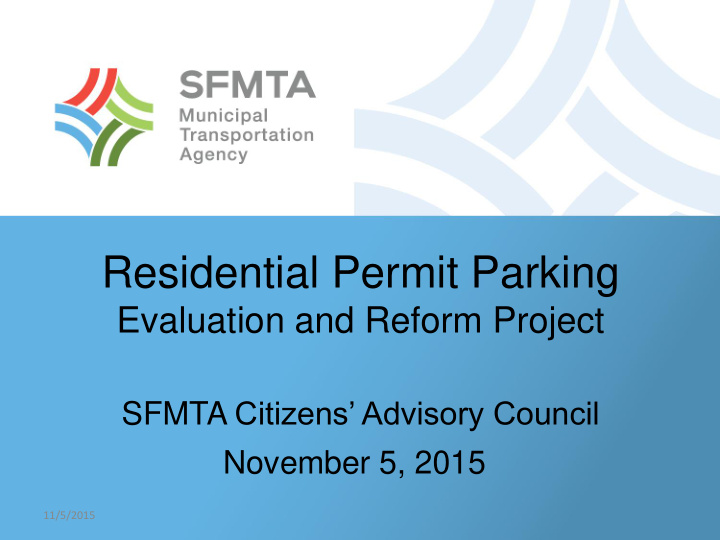



Residential Permit Parking Evaluation and Reform Project SFMTA Citizens’ Advisory Council November 5, 2015 11/5/2015
Overview 2 1. Key issues to address 2. Timeline 3. Project components 4. Research highlights 5. Public engagement 6. Early accomplishments 7. Next steps 11/5/2015
Key Issues 4 • Supporting City transportation demand management policies • Enhancing customer service • Sustainably balancing curb supply with the demands of multiple users 11/5/2015
Key Issues 3 • Area Q established in March 2015 • Public raised concerns: – Easier access to short-term permits – Modified pricing for motorcycles – Business permit changes – Parking for public & non-profit service providers 11/5/2015
Project Timeline 5 Fall 2016 2015 Winter 2016 Policy Policy Research Recomen- Analysis dations Public Outreach and Communications 11/5/2015
Program Components 6 Research: • Best practices • Existing parking occupancy and utilization • Program status • Parking demand factors • Household survey 11/5/2015
Residential Permit Parking Areas 7 29 permit areas 95,000 permits issued annually 153,000 eligible households (44% of S.F. households) 78,000 permitted parking spaces (28% of on-street parking) RPP covers 25% of City’s geography 11/5/2015
Research Highlights: Permit Issuance 8 Households by Number of Permits Issued 1.3% 0.2% 5% 1 permit 23% 2 permits 3 permits 4 permits 71% 5+ permits* *Note: Each household may purchase up to four permits. Additional permits may be requested by petition. 11/5/2015
Research Highlights: Permit Saturation 9 11/5/2015
Research Highlights: Vehicle Availability 10 11/5/2015
Research Highlights: Journey to Work (Transit, Walk, and Bicycle) 11 11/5/2015
Research Highlights: Journey to Work (Drive Alone and Carpool) 12 11/5/2015
Permit Area Snapshots 13 Area A Parking generators Russian Hill Attractions North Beach Worksites Telegraph Hill Neighborhood commercial Established 1978 Vehicle Availability Journey to Work Mode Spatial (Households) (Workers 16+) • 5,800 permitted parking spaces • 28 miles of blockface frontage • 0.70 square miles Demographics • Population: 28,600 • Households: 15,200 • Density: 41,300 people per sq mile 11/5/2015
Permit Area Snapshots 14 Area A Parking generators Russian Hill Attractions North Beach Worksites Telegraph Hill Neighborhood commercial Established 1978 • Permit saturation: 138% 7,960 1,559 (permits sold / parking spaces) Annual Permits Short-term Permits Resident: 7,590 1-Day: 635 • Citations: 15,808 Business: 259 2-Week: 375 Commercial: 15 4-Week: 179 (residential overstay) Med. caregiver: 23 6-Week: 51 Child caregiver: 12 8-Week: 319 Student: 23 Teacher: 38 Fire Station: 0 11/5/2015
Permit Area Snapshots 15 Area J Parking generators Inner Sunset UCSF Parnassus Cole Valley Muni Metro (N) Upper Haight Neighborhood commercial Established 1979 Vehicle Availability Journey to Work Mode Spatial (Households) (Workers 16+) • 4,000 permitted parking spaces • 22 miles of blockface frontage • 0.55 square miles Demographics • Population: 16,700 • Households: 7,600 • Density: 30,000 people per sq mile 11/5/2015
Permit Area Snapshots 16 Area J Parking generators Inner Sunset UCSF Parnassus Cole Valley Muni Metro (N) Upper Haight Neighborhood commercial Established 1979 • Permit saturation: 116% 4,622 572 (permits sold / parking spaces) Annual Permits Short-term Permits Resident: 4,280 1-Day: 248 • Citations: 7,293 Business: 73 2-Week: 121 Commercial: 6 4-Week: 88 (residential overstay) Med. caregiver: 6 6-Week: 25 Child caregiver: 26 8-Week: 90 Student: 184 Teacher: 43 Fire Station: 4 11/5/2015
Project Timeline 17 Fall 2016 2015 Winter 2016 Policy Policy Research Recommen- Analysis dations Public Outreach and Communications 11/5/2015
Program Components 18 Policy Evaluation Criteria • Improve customer service, reduce circling • Effective and efficient administration • Support Transit First and other City transportation policies (e.g., reducing VMT) • Balance mobility needs of residents with efficacy of entire transportation system • Stakeholder support 11/5/2015
Public Engagement 19 Phase I: Building Awareness • Household survey • Project briefing to neighborhoods, merchant associations, and other stakeholders • Project website • E-mail list for project updates 11/5/2015
Public Engagement 20 Phase II: Involving Stakeholders • Meetings with stakeholders: – neighborhood associations – merchant associations – City boards and commissions – other interest and stakeholder groups 11/5/2015
Early Accomplishments 21 • Improved mapping of RPP Areas w/ GIS • On-line petition being tested by residents of a proposed permit area • Parking occupancy and utilization survey • Household survey (launches mid-Nov) • Census data aggregated by permit area • Accommodations for mopeds in RPP Areas 11/5/2015
Next Steps 22 • Begin Phase I of public engagement • Complete research phase • Return to CAC in spring 2016 with update • QUESTIONS??? 11/5/2015
Recommend
More recommend